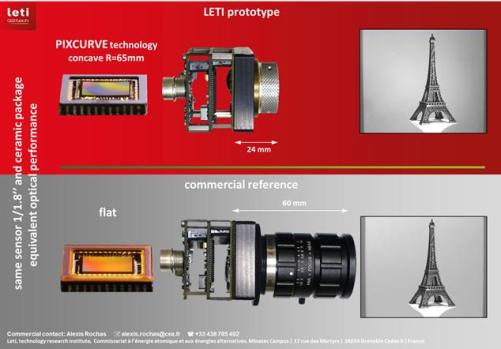The French research institute, Leti, has developed a prototype technology able to curve image sensors and micro-displays. Curving components like CMOS or CCD imagers can improve their performance, enhance the field of view, and compensate for optical aberrations.
Leti demonstrated its prototype called Pixcurve at SPIE Photonics West in San Francisco from 27 January to 1 February.
‘Curved sensor technology is a disruptive approach for imaging applications such as photography, videography, computer vision, surveillance and many other applications,’ said Bertrand Chambion, one of the co-authors of a paper presented at Photonics West. ‘In recent years, we have seen very strong interest in curved electronics, particularly for opto-electronics systems whose performance improves, while size, complexity and cost are reduced.’

Leti’s prototype with Pixcurve technology compared to a commercial reference: performance improves, while size, complexity and cost are reduced
The demonstration at the show was based on a 1/1.8-inch format, 1.3-million pixel CMOS image sensor. The standard sensor structure consists of a 7.74 x 8.12mm silicon die glued on a ceramic package. Electrical connections are wire bonded from the die to the package surface and, then, to the interconnection board. A glass cover is placed on top for mechanical protection.
Leti’s technology uses a grinding process to get the sensor below 100µm thick, which makes it mechanically flexible. It is then glued onto a curved substrate, which determines its final shape.
A wire bonding process developed for electrical connections is used to prevent damage on the thinned dies. The radius of curvature is R=65mm.
Leti’s process is compatible with any sensor size and with large-scale manufacturing processes. Potential uses for the technology include curving sensors for mobile phones, cameras, telescopes, medical imaging tools and industrial control equipment. Other uses include infrared sensors for astronomy, defence, drones, as well as micro-displays for automotive applications, and augmented and virtual reality.
Leti also presented a paper at Photonics West on its new lens-free microscope, which provides point-of-care diagnosis for spinal meningitis. The microscope can count white blood cells in cerebrospinal fluid – which is how the infection is diagnosed – in an automated way.
Spinal meningitis is an acute inflammation of the membranes covering the brain and spinal cord, which can be fatal within 24 hours.
Until now, early diagnosis of the infection required an operator using an optical microscope to manually count white blood cells in cerebrospinal fluid. As a result, meningitis cannot be diagnosed in emergencies or operating rooms, or during routine medical care in developing countries.
Leti’s lens-free, operator-free technology requires fewer than 10 microlitres of cerebrospinal fluid to differentiate between white and red blood cells, and can give a reading almost in real time.
The lens-free microscope was tested on 200 patients at Marseille Timone Hospital in France to detect or confirm spinal meningitis. A blind lens-free microscopic analysis of 116 cerebrospinal fluid specimens, including six cases of microbiologically confirmed infectious meningitis, yielded 100 per cent sensitivity and 79 per cent specificity.

